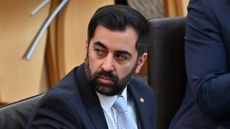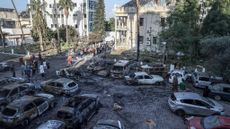MH17 - just another mistake: remember the USS Vincennes
America never apologised for shooting down an Iranian passenger jet, killing 290 people, 66 of them children

In the dismal book-keeping of civilian airliners shot down by military forces, the destruction of Malaysian Airlines Flight MH17 is as clear an example as any of an incident in the cock-up column rather than the conspiracy column. It should come as no surprise that US intelligence officials briefed reporters yesterday that the plane was most likely hit by mistake.
Russian-backed Ukrainian separatists did not intend to bring down a civilian airliner; what they wanted to do was to shoot down a Ukrainian air force plane. It was not an act of terror but an act of war: in the most brutal and unforgiving style of warfare known to mankind, civil war.
There seems little doubt that the missile that destroyed the plane was supplied to Ukrainian separatists by Russia. President Putin, who runs a tight ship, must have given authorisation. However, he clearly did not intend the weapons to be used against civilians and wasn’t expecting what happened.
Subscribe to The Week
Escape your echo chamber. Get the facts behind the news, plus analysis from multiple perspectives.

Sign up for The Week's Free Newsletters
From our morning news briefing to a weekly Good News Newsletter, get the best of The Week delivered directly to your inbox.
From our morning news briefing to a weekly Good News Newsletter, get the best of The Week delivered directly to your inbox.
Nor was anyone else. Despite a stream of intelligence suggesting that anti-aircraft weapons had been made available to separatists, much of it made public in the past few days by Secretary of State John Kerry, Western aviation authorities with whom much of the most sensitive intelligence is shared urgently declined to declare Eastern Ukraine off limits. In hindsight, this looks sloppy.
Sadly, there is an extensive archive of similar tragedies – most of them cock-ups too. On October 4, 2001, 64 passengers and 12 crew members onboard a Siberian Airlines Tupolev Tu-154 en route from Tel Aviv to Novosibirsk were killed when the plane was shot down over the Black Sea… by a Ukrainian missile.
It took a while for Ukraine to come clean but its then president, Leonid Kuchma, to his credit accepted that the Ukrainian military had screwed up during a major live-firing air defence exercise. An S-200 ground-to-air missile (Nato codename Gammon) missed its drone target 20 miles off the Crimean coast and locked on to the next biggest flying metal object on its radar – Siberian Airlines Flight 1812 some 150 miles away.
More relevant today to those political leaders who seek to raise tensions between the West and Russia is the USS Vincennes incident of 3 July 1988. The US Navy destroyer shot down Iran Air Flight 655 as it crossed the Straits of Hormuz, mistaking it for an Iranian Air Force jet. All 290 on board were killed, including 66 children.
The ship’s captain William Rogers III remained in command of the ship until 1989 when he was decorated with the Legion of Merit "for exceptionally meritorious conduct in the performance of outstanding service as commanding officer ... from April 1987 to May 1989”.
The United States has never apologised: although it eventually paid compensation to the relatives of the victims.
It doesn’t entirely let Putin off the hook. It was reckless to lend sophisticated military equipment to partly trained rebels who seemed unable to differentiate between military and civilian aircraft.
Interestingly, some experts at the time felt the deployment of highly sophisticated but unproven air defence destroyers like the USS Vincennes to the Gulf in 1981 was a disaster waiting to happen. The equipment was state-of-the-art but the interface with human operators was poor. The warfare centre on Vincennes had a Star Trek feel – big screens and complex displays - but there was not enough normal lighting for a petty officer who sensed an impending disaster to read the computer print-out of civilian flights authorised for that day.
The separatists sponsored by Putin misidentified a plane at 33,000ft. The highly trained crew of the Vincennes made the same mistake on an aircraft almost within view at 7,000ft.
The behaviour of some of the Russian separatists on the ground appears to have been disgraceful with bodies looted. Although to be fair, many locals have done their best to treat human remains and effects with respect. One way President Putin can redeem himself, is to insist that all property looted from the site by whomsoever is returned immediately to his representatives for identification and onward transmission to loved ones. Wedding rings and mementoes of other kinds matter in death. It should be a matter of a couple of telephone calls for an ex-KGB lieutenant-colonel – let alone a body-building, karate black belt President of Russia.
Finally, I am left with two thoughts about this tragedy. First, what on earth were civilian airliners doing flying over Eastern Ukraine in the first place? As a teenager on holiday flights to Hong Kong in the early 1970s our aircraft diverted well south of Vietnam – just in case. Are commercial pressures such that we can’t take sensible precautions any more?
Second, when these awful incidents happen from time to time what we do not need is for the political temperature to be increased by the likes of David Cameron – one of those rare politicians who seems to have immatured in office.
Aside from the raw grief of many relatives shown on television the most moving images to come out of the disaster for me were the photographs of Holland’s beautiful new Queen, Maxima, drained and distraught but dignified on her way back from comforting the bereaved. Comfort, if any is possible, not confrontation, should be the message.
There is no mending this – let’s not pretend there is. It was ghastly mistake.
Create an account with the same email registered to your subscription to unlock access.
Sign up for Today's Best Articles in your inbox
A free daily email with the biggest news stories of the day – and the best features from TheWeek.com
-
 Quiz of The Week: 20 - 26 April
Quiz of The Week: 20 - 26 AprilPuzzles and Quizzes Have you been paying attention to The Week's news?
By Rebecca Messina, The Week UK Published
-
 Humza Yousaf clears the decks to battle no-confidence vote
Humza Yousaf clears the decks to battle no-confidence voteSpeed Read First minister is 'done', according to insider, but a single vote could change the balance
By Arion McNicoll, The Week UK Published
-
 Immunotherapy and hay fever
Immunotherapy and hay feverThe Explainer Research shows that the treatment could provide significant relief from symptoms for many hay fever sufferers
By Richard Windsor, The Week UK Published
-
 Puffed rice and yoga: inside the collapsed tunnel where Indian workers await rescue
Puffed rice and yoga: inside the collapsed tunnel where Indian workers await rescueSpeed Read Workers trapped in collapsed tunnel are suffering from dysentery and anxiety over their rescue
By Sorcha Bradley, The Week UK Published
-
 Gaza hospital blast: What the video evidence shows about who's to blame
Gaza hospital blast: What the video evidence shows about who's to blameSpeed Read Nobody wants to take responsibility for the deadly explosion in the courtyard of Gaza's al-Ahli Hospital. Roll the tape.
By Peter Weber, The Week US Published
-
 Giraffe poo seized after woman wanted to use it to make a necklace
Giraffe poo seized after woman wanted to use it to make a necklaceTall Tales And other stories from the stranger side of life
By Chas Newkey-Burden, The Week UK Published
-
 Helicopter sound arouses crocodiles
Helicopter sound arouses crocodilesTall Tales And other stories from the stranger side of life
By Chas Newkey-Burden, The Week UK Published
-
 Woman sues Disney over 'injurious wedgie'
Woman sues Disney over 'injurious wedgie'Tall Tales And other stories from the stranger side of life
By Chas Newkey-Burden, The Week UK Published
-
 Emotional support alligator turned away from baseball stadium
Emotional support alligator turned away from baseball stadiumTall Tales And other stories from the stranger side of life
By Chas Newkey-Burden, The Week UK Published
-
 Europe's oldest shoes found in Spanish caves
Europe's oldest shoes found in Spanish cavesTall Tales And other stories from the stranger side of life
By Chas Newkey-Burden, The Week UK Published
-
 Artworks stolen by Nazis returned to heirs of cabaret performer
Artworks stolen by Nazis returned to heirs of cabaret performerIt wasn't all bad Good news stories from the past seven days
By The Week Staff Published